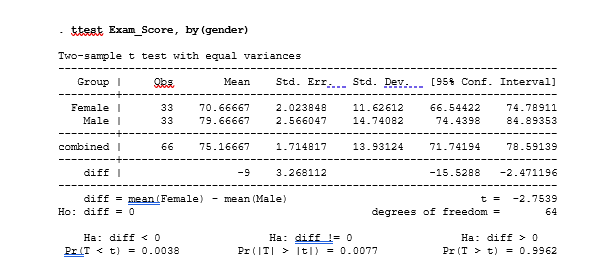Independent Samples T-test in STATA
Learn the Independent Samples T-test in STATA with our comprehensive guide. If you need an STATA expert for your data analysis, click below to Get a Free Quote Now!
Introduction
OnlineSPSS.com provides tailored statistical services for PhD students, researchers, and academics. We specialize in statistical data analysis and consulting, using advanced tools like STATA to help with dissertations, theses, capstone projects, and other research tasks.
- Services For: PhD Students, Researchers, Academics
- Academic Projects Supported: Dissertations, Theses, Capstone Projects, Academic Research, Assignments
- Services Provided: Data Management, Data Analysis, Writing Methodology, Writing Academic Results, Statistical Consulting
In this blog post, we will focus on how to conduct an Independent Samples t-Test in STATA. This statistical test is essential for comparing the means of two independent groups, such as male and female exam scores.
Understanding how to correctly perform and interpret an Independent Samples t-test in STATA is crucial for ensuring the validity of your research findings. By the end of this post, you will be equipped with the knowledge to execute this test effectively, allowing you to draw accurate conclusions from your data.
Whether you need help with STATA, SPSS, or any other statistical software, OnlineSPSS.com connects you with experienced statisticians who can guide you through every step of your project. Get started by requesting a FREE Instant Quote now.
PS: Need Independent Samples T-test in SPSS or R? Check out our guides for SPSS and R here.
2. What is the Independent Samples t-test and Its Assumptions and Hypothesis?
The Independent Samples t-Test is used to determine whether there is a statistically significant difference between the means of two independent groups. This test is commonly applied in research where two groups, such as males and females, are compared. The assumptions of the test include the independence of observations, normality of data within each group, and homogeneity of variances between groups.
The hypotheses for the Independent Samples t-Test are straightforward. The null hypothesis states that there is no difference between the group means, while the alternative hypothesis suggests that a significant difference exists. Ensuring these assumptions are met is critical before proceeding with the test, as violations can lead to inaccurate results.
3. Example for Independent Samples Test using STATA
To illustrate the Independent Samples t-Test in STATA, let’s consider a scenario where you compare exam scores between male and female students. First, you collect the exam scores for both groups. This data will serve as the foundation for your analysis. By performing the Independent Samples t-Test in STATA, you can determine if there is a statistically significant difference in performance between the two groups.
For instance, if the average exam score for males is higher than for females, the test will help you understand whether this difference is due to chance or reflects a real difference in performance. This example highlights the practical application of the Independent Samples t-Test in STATA.
4. How to Perform Independent Samples Test in STATA?
Performing an Independent Samples t-Test in STATA involves several steps. Firstly, load your dataset using the “use” or “import” command. Secondly, ensure that your data meets the assumptions of the test by using commands like “summarize” for descriptive statistics and “graph” for visual checks.
Next, you can run the Independent Samples t-Test by using the command ttest variable, by(group), where variable is your dependent variable (e.g., exam scores) and group is your independent variable (e.g., gender). STATA will then provide the output, including the t-value, degrees of freedom, and p-value, which are essential for interpreting the results.
5. STATA Output for Independent Samples Test
The output from STATA for an Independent Samples t-Test includes several key tables:
- Descriptive Statistics Table: Provides the mean, standard deviation, and sample size for each group. This table helps in understanding the basic distribution of your data.
- t-Test Table: Shows the t-value, degrees of freedom, and p-value, which are crucial for determining whether the difference between groups is statistically significant.
- Variance Table: Tests the equality of variances between the two groups, which is important for validating the assumptions of the t-test.
Each of these tables provides vital information necessary for interpreting the results of the Independent Samples t-Test in STATA.
6. Interpret the Key Results for Independent Samples t-Test
Interpreting the results of an Independent Samples t-Test in STATA involves examining the p-value and t-value from the output. A p-value less than 0.05 typically indicates a statistically significant difference between the group means. This result suggests that the difference in exam scores between male and female students is unlikely to be due to random chance.
Additionally, reviewing the descriptive statistics allows you to see the magnitude of the difference between groups. Understanding these key results enables you to draw accurate and meaningful conclusions from your data, which is essential for robust academic research.
7. Final Thoughts and Further Support
At OnlineSPSS.com, we are dedicated to helping PhD students and researchers with their statistical analysis needs, especially when using STATA. Whether you’re working on a dissertation, thesis, or another academic project, we offer a wide range of services to support you.
Explore our specialized pages for more information:
- STATA Dissertation Help (Marketing Dissertation, Psychology Dissertation, Sociology Dissertation, Public Health Dissertation, Economics Dissertation)
- Pay Someone to Do My STATA Project
- STATA Help for Statistical Analysis
- Find a STATA Helper for Research
- Hire a STATA Expert for Academic Research
- STATA Expert Help
- Online STATA Help
Whether you are a beginner or need help with advanced features, this service enables you to apply the correct techniques to your specific marketing research questions, leading to robust results. For a tailored solution, get your free instant quote now.



